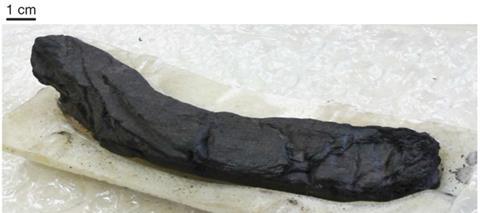Scroll from town destroyed in Vesuvius eruption over 2000 years ago deciphered

Scientists in Italy have managed to decipher text on a badly scorched papyrus roll from Herculaneum, a town destroyed with Pompeii in the Mount Vesuvius eruption of 79AD. The imaging technique they used may allow archaeologists to analyse other texts previously thought to be too badly damaged to read.
Hundreds of carbonised papyrus rolls were excavated from the ‘Villa of the Papyri’ in Herculaneum in 1754, said to contain the only surviving library from antiquity. Many of the texts were later stored in the National Library of Naples and several were given to Napoléon Bonaparte as a gift in 1802.
‘The scrolls are a very well-known and important resource for specialists because we’ve lost most of the texts from antiquity,’ says study author Vito Mocella, from the National Research Council’s Institute of Microelectronics and Microsystems in Italy.
Mocella and his colleagues were keen to read the text within the contorted layers of this burned papyrus roll but didn’t want to unroll it, as this would irreversibly damage the artefact. The team thought that x-ray computed tomography (XCT) might provide the solution to this problem. This is because XCT can build up a 3D overview of the inside of the specimen by using x-rays to generate a cross-sectional stack of 2D images that can be then be combined.
Mocella points out, however, that this basic principle was not enough to generate the contrast needed to image the ink against the burned papyrus. ‘XCT cannot distinguish between materials that are very similar from a chemical point of view,’ he explains. ‘In antiquity, the inks were essentially carbon-based and the papyri [under investigation] have been carbonised.’ This chemical similarity means that both the ink and papyrus absorb x-rays at similar levels and the words are lost.
The team managed to get around this problem by using x-ray phase contrast tomography (XPCT). This modified form of XCT does not rely on differing levels of absorption but on how the x-ray is refracted through each of the different materials to generate the high contrast needed. Once the papyrus is in position, it is rotated through 360° as the x-ray beam scans across it and the emitted x-rays are collected to produce the 3D image.
Upon exposing the scroll, Mocella and his colleagues were able to image several letters of the Greek alphabet through the dense layers of ancient paper. The clear contrast also allowed the group to compare the style of writing from the damaged scroll to another salvaged papyrus to determine the specimen’s age and author. It is most likely that part of the text was from the hand of Philodemus, a philosopher who based his works on the teaching of Epicurus. Mocella says that in time it should be possible to read a ‘significant part of the text’ and that it’s all a question of improving current data analysis techniques.
Graham Davis, a specialist in x-ray microtomography from the Queen Mary University of London, UK, believes the work is a ‘major step forward’. ‘It’s obviously early days but it has answered a fundamental question,’ Davis tells Chemistry World. ‘The real question was whether there was a method of retrieving text that was written with carbon ink and here’s the answer.’












No comments yet